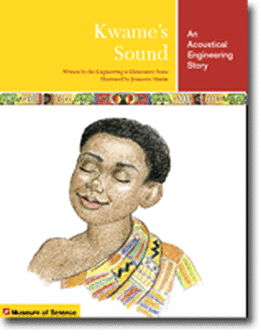
Kwame is an aspiring musician who is about to perform at Odwira, a huge musical festival in Ghana. He's going to perform with his cousin, Kofi, who lives far away. Both Kwame and Kofi want to perform their best, but Kwame can't read music in the same way as everyone else because he is blind.
Learning about how sound can change in many ways (pitch, volume, and duration), Kwame learns how sound can be represented by using different objects to represent different sounds. If the representation he makes accurately represents the sounds he needs to perform at Odwira, then he and Kofi will perform well!
Kwame extends what he has learned to help identify different birds out in the wild with the help of a field biologist. If each bird has a unique sound, they a unique spectrogram can be created to identify one bird from another. Connecting what he has learned to actual work done by acoustical engineers, regardless of whether someone can see or not, sound can be represented in other ways!
Key Vocabulary: acoustical engineer, sound, vibrations, energy, pitch, duration, volume, damp, spectrogram
Learning about how sound can change in many ways (pitch, volume, and duration), Kwame learns how sound can be represented by using different objects to represent different sounds. If the representation he makes accurately represents the sounds he needs to perform at Odwira, then he and Kofi will perform well!
Kwame extends what he has learned to help identify different birds out in the wild with the help of a field biologist. If each bird has a unique sound, they a unique spectrogram can be created to identify one bird from another. Connecting what he has learned to actual work done by acoustical engineers, regardless of whether someone can see or not, sound can be represented in other ways!
Key Vocabulary: acoustical engineer, sound, vibrations, energy, pitch, duration, volume, damp, spectrogram
 RSS Feed
RSS Feed